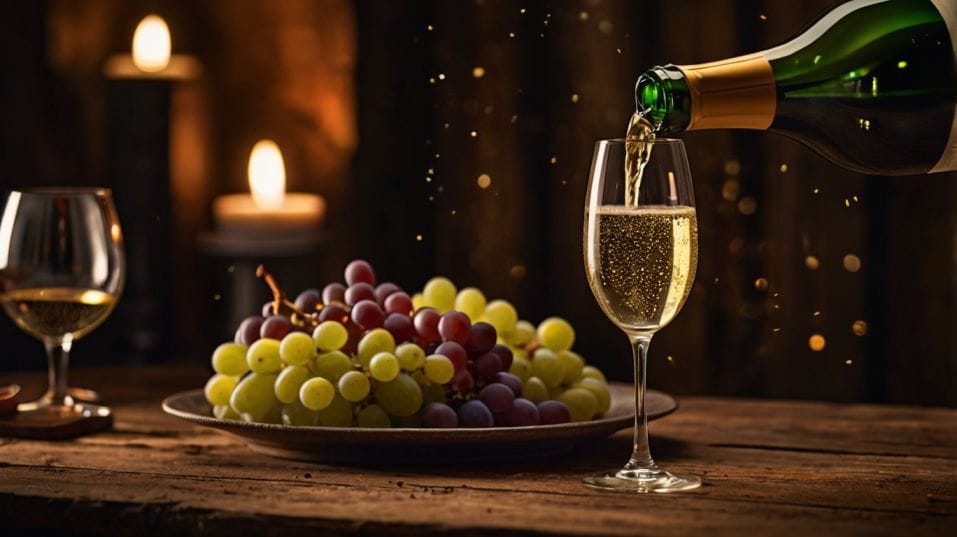Sparkling Wine Isn’t Just for Celebrations
Sparkling wine is more than celebration. Learn how bubbles boost flavor, train your palate, and elevate everyday meals with confidence.

Ever wondered why sparkling wine is always the opener, never the main event? It’s time to flip that thinking. Far from just festive fluff, sparkling wine offers one of the most dynamic tasting experiences in the wine world.
The bubbles aren’t just for show—they’re structure, texture, and training ground for your palate. Whether you're new to wine or building confidence, learning to taste sparkling wine sharpens your senses faster than any still bottle ever could.
The Engine Behind the Bubbles
At its core, sparkling wine is a study in tension and transformation. You’re tasting a wine that’s gone through a second fermentation, often inside the very bottle you’re drinking from.
That extra fermentation adds pressure—literally—and texture, complexity, and stability.
Whether it’s made using the traditional method (like Champagne or Cava), the tank method (like Prosecco), or the ancestral method (like pét-nat), each style expresses something unique.
But what links them all is their backbone: acidity. Sparkling wines are built on bright, high-acid base wines. This is why they stay refreshing, energetic, and food-flexible.
You’re not just tasting fruit—you’re feeling structure. That matters more than vintage or prestige when you’re training your palate.

A Wine That Trains Your Senses
Sparkling wine doesn’t let you coast. The bubbles activate your palate. They lift aromas and drive flavors forward, forcing you to pay attention. That’s why even a modest bottle can teach you more than a still wine twice the price.
Drink slowly. Let the mousse (that creamy foam) hit your tongue. Notice how the bubbles affect perception—sharpening citrus notes, stretching out minerality, or making sweetness feel lighter than it is.
If you're new to tasting analytically, sparkling wine gives you structure and repetition. And structure is where nuance lives.
As you move between brut, extra brut, and brut nature, you begin to sense how just a few grams of sugar dramatically shift the mouthfeel, weight, and length of a wine.
You're not memorizing terms—you’re building muscle memory. The more you taste, the more intuitive it becomes.
Breaking the Flute Habit
Drinking sparkling wine well also means breaking a few outdated habits. The classic tall flute might look elegant, but it actively hides the wine’s character.
Aromas stay trapped. Texture feels narrow. Switch to a white wine glass, or even a small Burgundy stem, and suddenly the wine breathes. You catch floral tones, deeper fruit, and the complexity of aging—notes that matter more than sparkle.
Serving Smart
Serving temperature matters, too. Overchilling sparkling wine—straight from the back of the fridge or an ice bucket—locks up the nose and tightens the palate.
Let it sit for a few minutes before your first sip. Slightly warmer, and it softens just enough to open up. Like most great wines, it reveals itself with a bit of air and time.
And if you don’t finish the bottle? Use a Champagne stopper and keep it in the fridge. Many high-quality sparklers hold up beautifully over a day or two. Some even improve.
From Aperitif to Main Course
You don’t need a menu full of oysters and caviar to make sparkling wine work. In fact, bubbles shine best in everyday situations. Fried chicken, potato chips, tempura, triple-cream cheese, buttered popcorn—this isn’t irony. It’s chemistry.
That high acidity and effervescence act as a reset button with every bite. They slice through fat, salt, and umami, leaving your palate refreshed and ready. No still wine does this quite the same way.
Built for the Table
Sparkling wine can even carry a meal. Try a vintage Champagne or bottle-fermented sparkling rosé with roast chicken, risotto, or seared scallops.
These wines have depth, structure, and quiet power. They're not lightweights—they’re precise tools, capable of elevating a dish without overpowering it.
This is where sparkling wine separates itself: it behaves more like an ingredient than a beverage. It becomes part of the experience, not just a side note.
Flavor Over Flash
There’s a difference between choosing wine and following hype. A smart wine drinker doesn’t get distracted by labels or trends—they learn to read cues.
With sparkling wine, that means understanding what influences taste: grape varieties, production method, aging time, and dosage level.
A non-vintage brut from a co-op will taste tight, linear, and refreshing. A bottle aged on the lees for several years will lean toasty, savory, even nutty.
A pét-nat might show more rustic, wild fruit and cloudiness. None are “better” than the other—just different expressions, for different moods and meals.
When you move past the idea of sparkling wine as a category and start thinking about it as a technique, you get better at choosing.
You ask the right questions. You build a vocabulary of texture and finish. And you become the kind of drinker who knows what they like and why.
Final Thoughts
Sparkling wine isn’t just a celebration—it’s an education. It sharpens your senses, deepens your understanding of balance, and makes you a better taster across the board.
Whether you're exploring traditional-method grower bottles or crisp, floral Prosecco, the key is to engage with intention.
Don’t wait for a toast. Open a bottle this week with food you love. Pour it into the right glass, take your time, and pay attention to how it moves, not just how it sparkles. When you treat sparkling wine like serious wine, it rewards you in kind.




